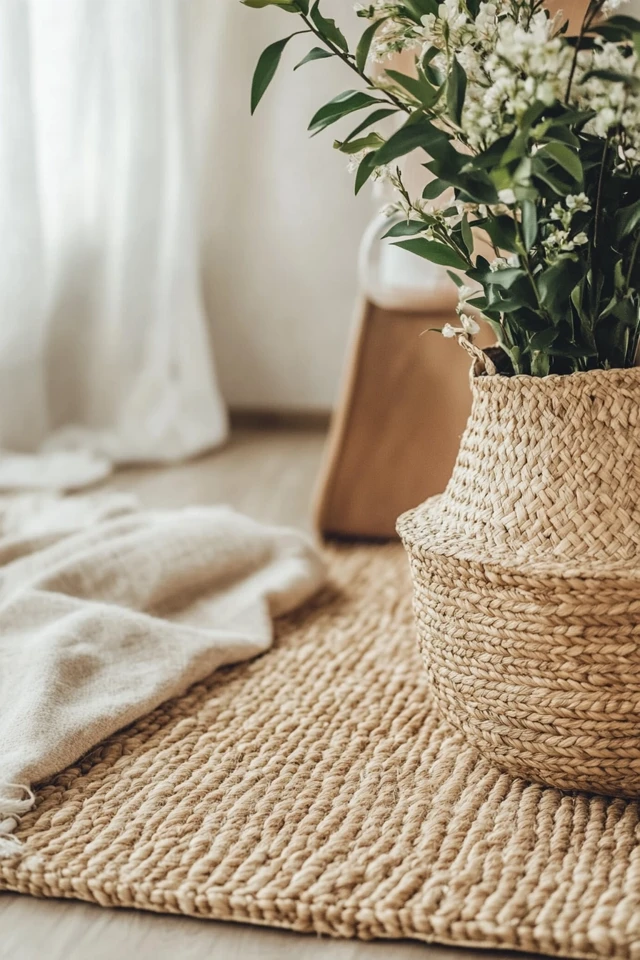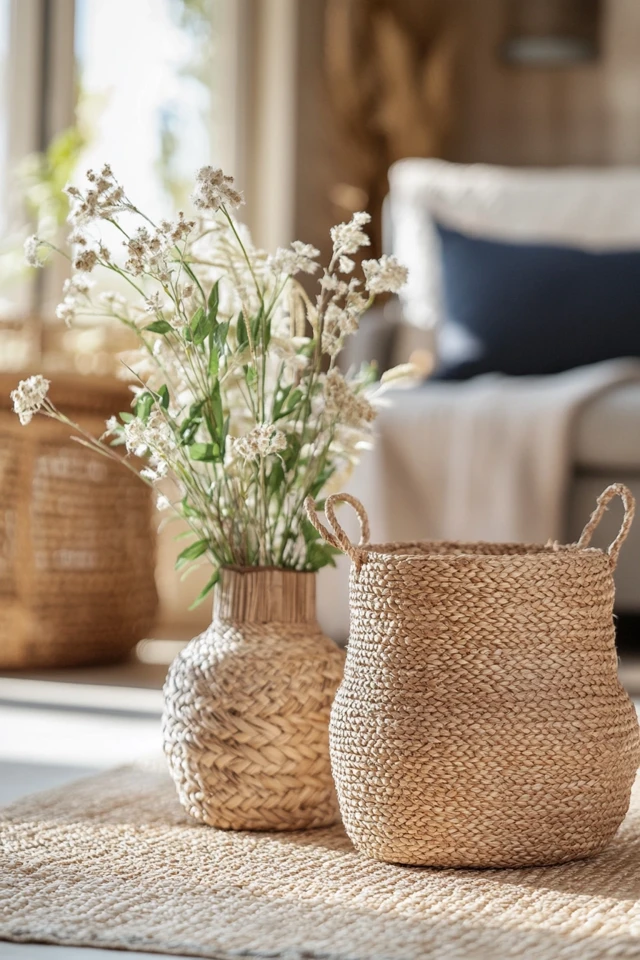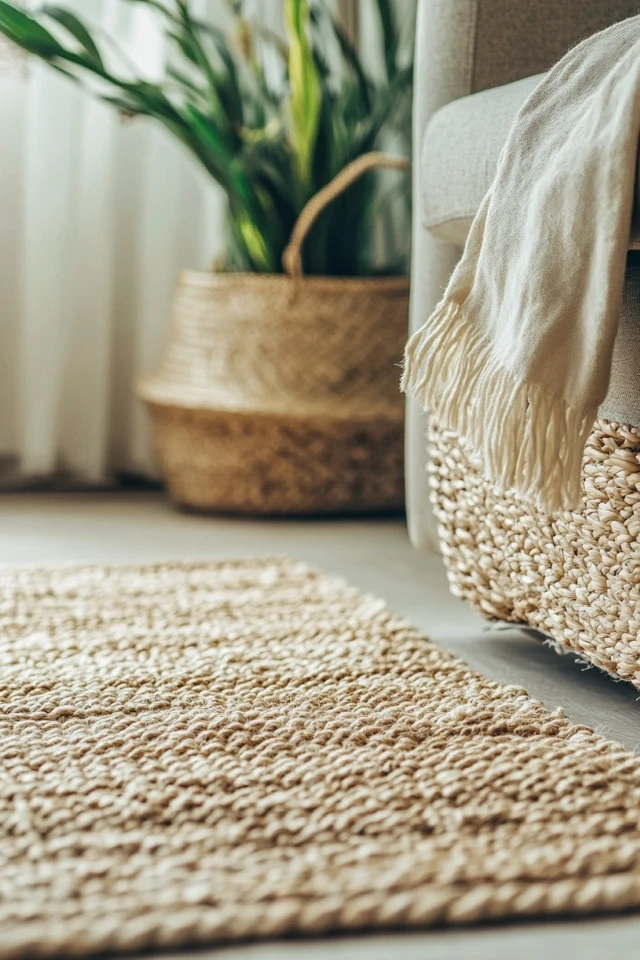Scandinavian design is synonymous with minimalism, functionality, and comfort, but it’s the addition of woven textures that brings warmth and depth to this style. Whether it’s a handwoven rug, a rattan chair, or a cozy wicker basket, these elements create a tactile, inviting environment while maintaining the clean, understated aesthetic of Scandinavian interiors.
My own love for Scandinavian design deepened when I moved into a small apartment with stark white walls and light wood floors—a blank canvas begging for personality. Adding woven textures transformed the space instantly. A braided jute rug grounded the living room, while a wicker pendant light added warmth overhead. These simple yet effective changes turned a cold, impersonal space into a cozy retreat, embodying the Scandinavian concept of “hygge” (a sense of comfort and well-being).
If you’re looking to incorporate woven textures into your Scandinavian-inspired home, this guide will help you create a harmonious balance between functionality, minimalism, and warmth.
Why Woven Textures Work in Scandinavian Design
1. Warmth and Comfort
Scandinavian design often features a neutral color palette and sleek surfaces, which can feel stark if not balanced with softer textures. Woven materials, such as wool, jute, or rattan, add a sense of warmth and coziness to the space.
2. Natural Elements
Woven textures are often crafted from natural materials like cotton, seagrass, and wicker, which align perfectly with the Scandinavian emphasis on sustainability and a connection to nature.
3. Tactile Depth
The subtle patterns and textures of woven materials introduce depth and dimension to a space, preventing it from feeling flat or sterile.
4. Versatility
Woven textures work across a variety of elements, from furniture and lighting to accessories like rugs, baskets, and cushions. They’re easy to integrate into any room, whether it’s a living space, bedroom, or kitchen.
Key Woven Elements to Incorporate
1. Rugs
Woven rugs are a staple in Scandinavian design. Look for options like braided jute, handwoven wool, or flatweave cotton rugs in neutral tones.
Example: A large jute rug in the living room anchors the furniture while adding a soft, earthy texture underfoot.
2. Rattan and Wicker Furniture
Rattan chairs, wicker storage units, or even woven bed frames can bring a touch of vintage charm to a Scandinavian interior.
Tip: Pair a rattan accent chair with a minimalist wooden coffee table to balance the rustic texture with modern simplicity.
3. Woven Baskets
Practical and stylish, woven baskets are perfect for storage and décor. Use them to store blankets, toys, or even plants.
Example: A set of seagrass baskets by the sofa can hold cozy throws, keeping them within easy reach while adding a decorative touch.
4. Textiles
Soft woven textiles, like throws, pillow covers, and wall hangings, are an easy way to incorporate texture into your Scandinavian space.
Tip: Choose neutral or muted tones, like cream, gray, or sage green, to complement the rest of the décor.
5. Pendant Lighting
Woven pendant lights, often made of wicker or rattan, are both functional and sculptural. They cast a warm, diffused light while serving as a statement piece.
Example: Hang a woven pendant light above the dining table to create a focal point in the room.
6. Woven Headboards
A woven rattan or cane headboard can add warmth and texture to a minimalist Scandinavian bedroom.
Design Tip: Pair the headboard with crisp white bedding and a soft wool throw for a balanced look.
How to Incorporate Woven Textures Step-by-Step
Step 1: Start Small with Accessories
- Begin by adding woven baskets, pillows, or small rugs to introduce texture without overwhelming the space.
Step 2: Layer Textures
- Layer woven elements with other materials, such as linen curtains, wool throws, or leather furniture, for a rich, tactile environment.
Step 3: Choose a Focal Point
- Select one standout woven piece, like a rattan chair or a pendant light, to serve as the focal point of the room.
Step 4: Stick to a Neutral Palette
- Keep the color palette muted and natural to maintain the minimalist aesthetic of Scandinavian design.
Step 5: Add Greenery
- Complement woven textures with plants, which enhance the natural vibe and add a pop of vibrant green to the room.
Picture Gallery








FAQ Section
1. What materials are best for woven textures in Scandinavian design?
Jute, rattan, wicker, cotton, and wool are ideal for their natural, sustainable qualities and ability to add warmth.
2. How do I prevent woven textures from looking too rustic?
Pair them with sleek, modern furniture and a neutral color palette to maintain the minimalist aesthetic.
3. Can woven textures work in a small space?
Absolutely! Opt for smaller pieces like a wicker basket or a jute rug to add texture without overwhelming the room.
4. Are woven elements durable for high-traffic areas?
Yes, materials like jute and wool are incredibly durable and ideal for high-traffic spaces like entryways or living rooms.
5. How do I clean woven furniture and rugs?
For furniture, wipe with a damp cloth. For rugs, vacuum regularly and spot-clean spills as needed.
Variations
- Minimalist Approach: Stick to a single woven element, like a pendant light, to maintain a clean, pared-down look.
- Eclectic Twist: Combine woven textures with bold patterns, vibrant textiles, or colorful accents for a playful, bohemian vibe.
- Industrial Blend: Pair woven textures with metal furniture and concrete floors for an industrial-Scandinavian hybrid.
How to Showcase Woven Textures
Living Room Comfort
Add a jute area rug, a rattan accent chair, and woven baskets to create a cozy, inviting living space.
Bedroom Serenity
Incorporate a woven headboard, soft wool throws, and cane nightstands for a tranquil, textured retreat.
Dining Area Charm
Use a wicker pendant light above the dining table and woven placemats to enhance a Scandinavian dining area.
Conclusion
Woven textures are the perfect addition to Scandinavian design, bringing warmth, depth, and natural beauty to minimalist spaces. From jute rugs and rattan furniture to soft textiles and pendant lighting, these elements blend seamlessly into any room, enhancing both style and comfort. Whether you’re looking to transform an entire space or simply add a few accents, woven textures will elevate your Scandinavian-inspired home to the next level. So start experimenting today and discover the power of texture in creating a cozy, hygge-filled space!


